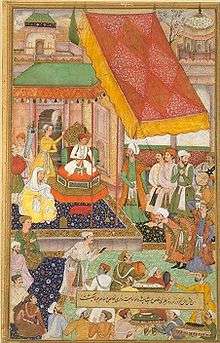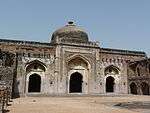Maham Anga
Maham Anga (died 1562) was the chief nurse of the Mughal emperor Akbar. A highly shrewd and ambitious woman, she was the political adviser of the teenage emperor and the de facto regent of the Mughal Empire from 1560 to 1562.[2]
Maham Anga | |
|---|---|
 Seated just below Akbar himself denotes Maham Anga's position in the Imperial court | |
| De facto regent of the Mughal Empire | |
| In office 1560–1562 | |
| Monarch | Akbar |
| Personal details | |
| Died | 25 June 1562[1] Agra, India |
| Spouse(s) | Nadim Khan |
| Children | Baqi Khan Adham Khan |
Biography
Maham Anga was Akbar's chief nurse prior to his enthronement at age thirteen as Mughal emperor in 1556. Her own son, Adham Khan,[3] as Akbar's foster brother, was regarded as almost one of the imperial family. Maham Anga, shrewd and ambitious and very much in charge of the household and harem, sought to advance her own authority and that of her son. In 1560, the two tricked Akbar into coming to India without his regent and guardian Bairam Khan and they were able to convince Akbar that now that he was seventeen, he did not need Bairam. Akbar dismissed his regent and sent him on a pilgrimage to Mecca. Months later, Bairam was murdered by an Afghan and much of the former's power passed on to Maham Anga.
Death
Adham Khan's violent execution for the murder of Ataga Khan, Akbar’s favourite general Shams-ud-Din, at the hands of the young Emperor himself no less in May, 1562, profoundly affected her. She famously commented You have done well to Akbar when he broke the news to her; she died shortly afterwards.
Her tomb and that of her son, known as Adham Khan's Tomb, was built by Akbar, and popularly named Bhul-bulaiyan, owing to the labyrinth in its structure, lies north of the Qutub Minar in Mehrauli.


Khairul Manazil
She also built a mosque, Khairul Manazil in 1561 CE in Mughal architecture. It later served as a madarsa, and now stands opposite, Purana Qila, Delhi on Mathura Road, south east to Sher Shah Gate.[4][5]
It was her slave that tried to kill Akbar, after his return from hunting and moving towards Nizamuddin Dargah, but the arrow hit a soldier in his entourage instead, who was hurt, albeit not gravely.[6]
In popular culture
- Ila Arun portrayed Maham Anga in the Bollywood film Jodha Akbar (2008).[7]
- A fictionalized Maham Anga was portrayed by Ashwini Kalsekar in Zee TV's fictional drama Jodha Akbar.[8]
- Jaya Bhattacharya portrayed Maham Anga in Sony TV's historical drama Bharat Ka Veer Putra - Maharana Pratap.[9]
References
- Ma'asir al-umara by Samsam ud Daula, vol. 1, pg. 158, Urdu Science Board, Lahore (2004)
- Jackson, Guida M. (1999). Women rulers throughout the ages : an illustrated guide ([2nd rev., expanded and updated ed.]. ed.). Santa Barbara, Calif: ABC-CLIO. p. 237. ISBN 9781576070918.
- Bonnie C. Wade (20 July 1998). Imaging Sound: An Ethnomusicological Study of Music, Art, and Culture in Mughal India. University of Chicago Press. pp. 95–. ISBN 978-0-226-86840-0.
turki woman married to.
- Sher Shah Gate Archived 4 March 2016 at the Wayback Machine IGNCA website.
- "Driving past Khairul Manzil". Indian Express. 26 April 2009.
- Masjid Khairul Manazil By Ahmad Rahmani milligazette. .
- "Who's who in Jodhaa Akbar". rediff.com. Retrieved 28 September 2017.
- Coutinho, Natasha (24 September 2014). "It isn't easy to let go: Ashwini Kalsekar". Deccan Chronicle. Retrieved 28 September 2017.
- Maheshwri, Neha (1 October 2013). "Ashwini Kalsekar, Jaya Bhattacharya on playing Maham Anga". The Times of India. Retrieved 28 September 2017.
Further reading
- Mughal Architecture of Delhi : A Study of Mosques and Tombs (1556-1627 A.D.), by Praduman K. Sharma, Sundeep, 2001, ISBN 81-7574-094-9. Chapter 4.
- B.V. Bhavan 'The Mughal Empire' (Bombay 1974) The Cambridge History of India v.4 Abu'l Fazl 'Akbarnama' Badauni.